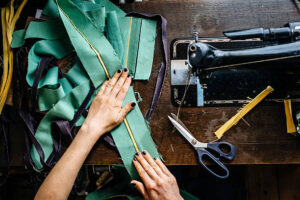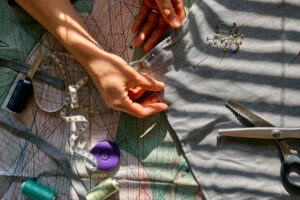Fashion Designer Jobs: The Ultimate Career Guide
Introduction
Fashion design is more than just an art form; it’s a creative journey where ideas, aesthetics, and business intertwine. Fashion designers are the masterminds behind the clothing and accessories that shape trends, express cultural identities, and even influence global movements. Whether it’s the haute couture runway or the latest street style, designers play a crucial role in how we present ourselves to the world. In this guide, we’ll explore what a career in fashion design entails, from the skills and qualifications you need to the career paths, challenges, and rewards of the industry.

What Does a Fashion Designer Do?
At its core, a fashion designer is a creative visionary who brings concepts to life. But the role is multi-faceted and involves a variety of tasks:
- Designing Apparel and Accessories: Fashion designers conceptualize and sketch designs, considering everything from fabric choice to color palettes. Their goal is to create pieces that reflect their unique vision while also appealing to the target market.
- Trend Research and Forecasting: Staying on top of trends is essential. Designers research seasonal color palettes, fabric innovations, and cultural movements to ensure their collections resonate with current tastes and future demands.
- Prototyping and Pattern Making: After finalizing a design, it’s time to bring it to life. Designers work closely with pattern makers and seamstresses to create samples, testing the fit, fabric, and functionality of the garments.
- Managing Production: Once the designs are approved, designers oversee the production process, ensuring the garments meet their quality standards and are delivered on time. This phase involves collaborating with manufacturers and managing the supply chain.
Fashion designers may specialize in different niches such as high fashion, ready-to-wear, accessories, or costume design, offering a wide array of career options within the field.

Key Skills and Qualifications
To thrive in the world of fashion design, certain skills and qualifications are non-negotiable. Here’s a breakdown of what it takes:
- Creativity and Innovation: Fashion design is rooted in creativity. Designers need a sharp eye for aesthetics, the ability to anticipate trends, and a flair for creating original designs that stand out.
- Technical Proficiency: Understanding garment construction, fabric properties, and pattern making is vital. Designers must be proficient with design software like CAD (computer-aided design) to streamline the design process and produce accurate technical drawings.
- Attention to Detail: The success of a design often comes down to the smallest details—how a fabric drapes, the stitching, or the choice of buttons. Precision is key in translating a design into a finished garment.
- Strong Communication Skills: Designers often collaborate with a range of professionals, from pattern makers to manufacturers. Being able to communicate your vision effectively is essential to making sure your designs come to life as intended.
- Educational Background: While a formal degree in fashion design is not always required, it certainly helps. Many designers pursue a bachelor’s or master’s degree in fashion or related fields. Internships and apprenticeships are also excellent ways to gain hands-on experience and learn from seasoned professionals.
-

Business woman, fashion designer and tablet in logistics, research or management at boutique. Female person or entrepreneur working on technology in storage or inventory check at retail store or shop
Career Paths and Specialisations
Fashion design isn’t a one-size-fits-all profession. There are several career paths and areas of specialization within the field:
- Haute Couture vs. Ready-to-Wear: Haute couture designers create high-end, custom garments for elite clientele, while ready-to-wear designers produce collections that are mass-produced and sold in retail stores.
- Fashion Illustration: For those who enjoy drawing and visual arts, fashion illustration can be a rewarding path. These artists create stunning sketches of clothing designs that are used for advertisements, catalogs, and editorial content.
- Textile Design: Textile designers specialize in the creation of fabrics and patterns. They collaborate closely with fashion designers to produce the materials that bring designs to life.
- Costume Design: Designers in this field focus on creating costumes for theatre, film, and television, blending creative flair with historical accuracy or fantasy elements, depending on the production.
- Sustainable Fashion: As environmental concerns grow, many designers are opting to create eco-friendly collections using sustainable fabrics, ethical manufacturing processes, and zero-waste practices.
The path you choose within fashion design can shape your career trajectory, with opportunities for both independent work and positions at large fashion houses.

Work Environment and Job Outlook
Fashion designers work in diverse environments depending on their chosen path:
- Fashion Houses and Retail Brands: Established fashion houses such as Chanel, Gucci, or Nike employ designers who contribute to creating seasonal collections. These positions typically provide job stability and opportunities for professional development.
- Freelancers and Independent Designers: Freelance designers have the flexibility to work for a range of clients or run their brand. However, this path requires strong entrepreneurial skills and the ability to handle all aspects of the business.
- Work Locations: Fashion designers are often found working in design studios, manufacturing facilities, or at fashion shows. Larger companies may provide state-of-the-art equipment and resources, while freelancers often set up their home studios.
The job outlook for fashion designers remains steady, with growth projected to align with consumer interest in fashion and a growing demand for sustainable and innovative designs. As fashion continues to evolve, the industry will seek fresh talent to meet the needs of a modern, conscious consumer.

Salary and Compensation
Salaries for fashion designers can vary significantly based on experience, location, and the sector in which they work:
- Average Salary: In the United States, the average salary for a fashion designer is around $75,000 per year, with entry-level positions starting at approximately $45,000, while highly experienced designers can earn $120,000 or more.
- Freelance vs. Full-Time: Freelancers can earn more per project but may face income fluctuations. In contrast, full-time designers often benefit from steady pay and additional perks such as healthcare and retirement plans.
- Bonuses and Perks: Many designers also receive bonuses based on the success of their collections or performance reviews. Some fashion companies provide additional perks, including travel opportunities, exclusive events, and access to industry-leading tools.
-

Tailors working in studio together
Challenges in the Fashion Design Career
Like any career in a competitive creative field, fashion design presents challenges that require perseverance and resilience.
- High Competition: The fashion industry is full of talented designers, making it difficult to stand out. It takes time to build a portfolio and network with the right people, but persistence is key.
- Fast-Paced Nature: Fashion is ever-evolving, and designers are under constant pressure to stay ahead of trends. This can lead to long working hours and tight deadlines, especially around fashion show seasons.
- Balancing Creativity with Practicality: Designers must learn to balance their creative visions with business requirements, such as budget constraints, consumer demand, and production feasibility.
Despite these challenges, a career in fashion design is highly rewarding for those passionate about the craft and willing to put in the hard work.
How to Get Started in Fashion Design
If fashion design is your dream career, here’s how to take the first steps:
- Get Educated: Consider pursuing a degree in fashion design or a related field. This will help you develop both your creative and technical skills. Alternatively, internships can provide invaluable hands-on experience.
- Build Your Portfolio: Your portfolio is your calling card in the fashion world. Create a collection of your best designs, sketches, and prototypes to showcase your abilities.
- Network and Connect: Attend fashion events, engage with professionals on social media platforms like Instagram, and connect with industry peers. Networking can open doors to internships, collaborations, and job opportunities.
- Stay Updated: Fashion is a rapidly changing industry. Stay current with the latest trends, fabric innovations, and new technologies, such as 3D design tools or sustainable practices.
Conclusion
A career in fashion design offers a world of creativity, innovation, and style. Whether you dream of dressing celebrities or creating the next fashion revolution, the opportunities are endless. By developing your skills, building a strong portfolio, and staying motivated, you can make your mark in this exciting industry. Embrace the challenges, trust your creativity, and take the steps needed to turn your passion for fashion into a successful career.
